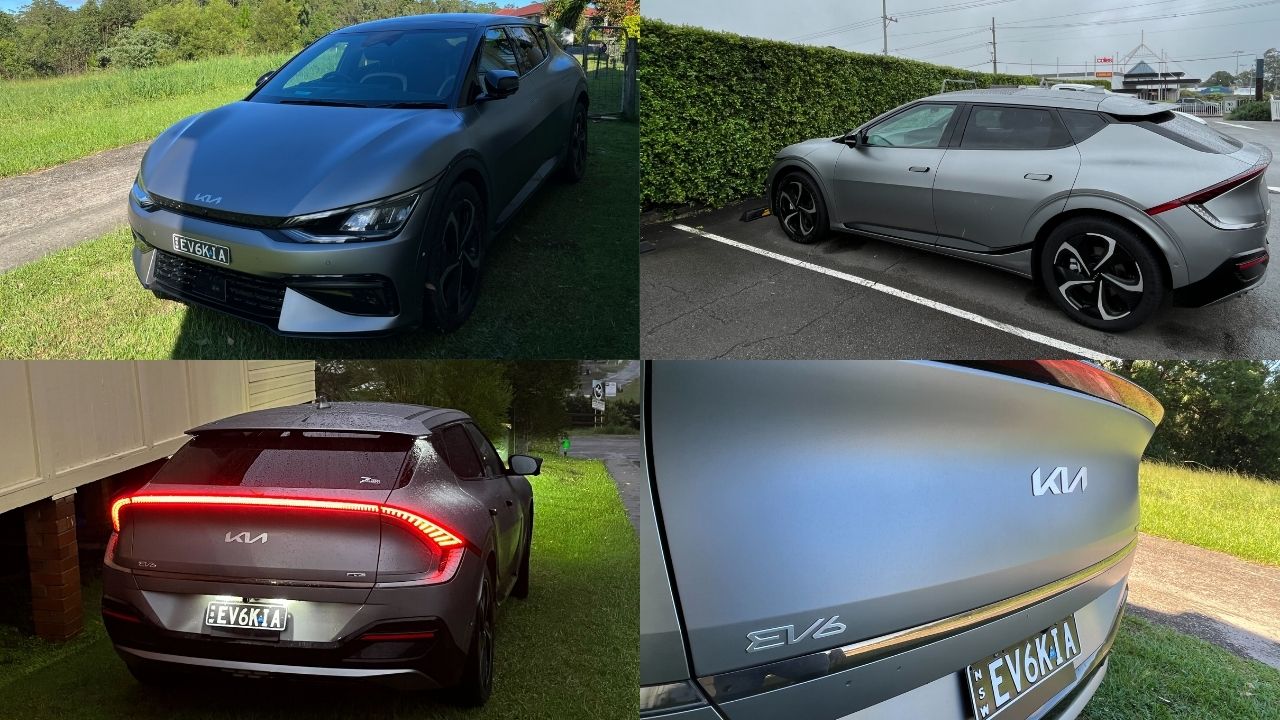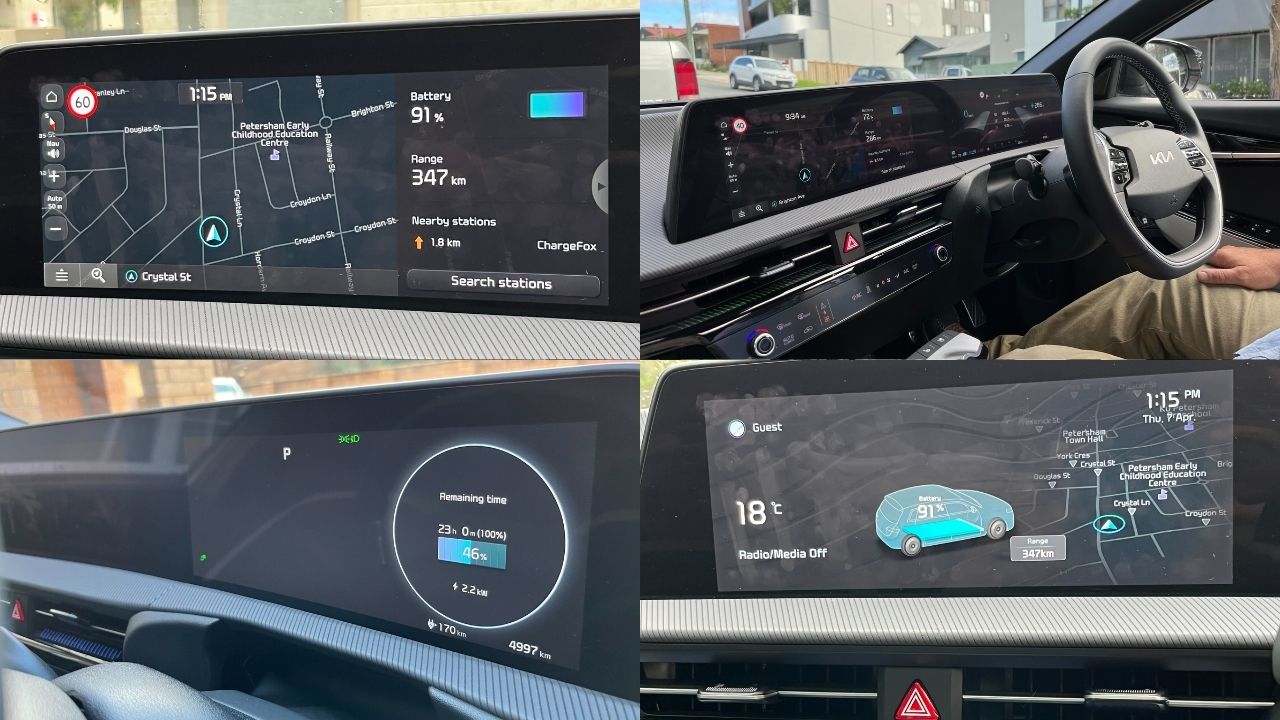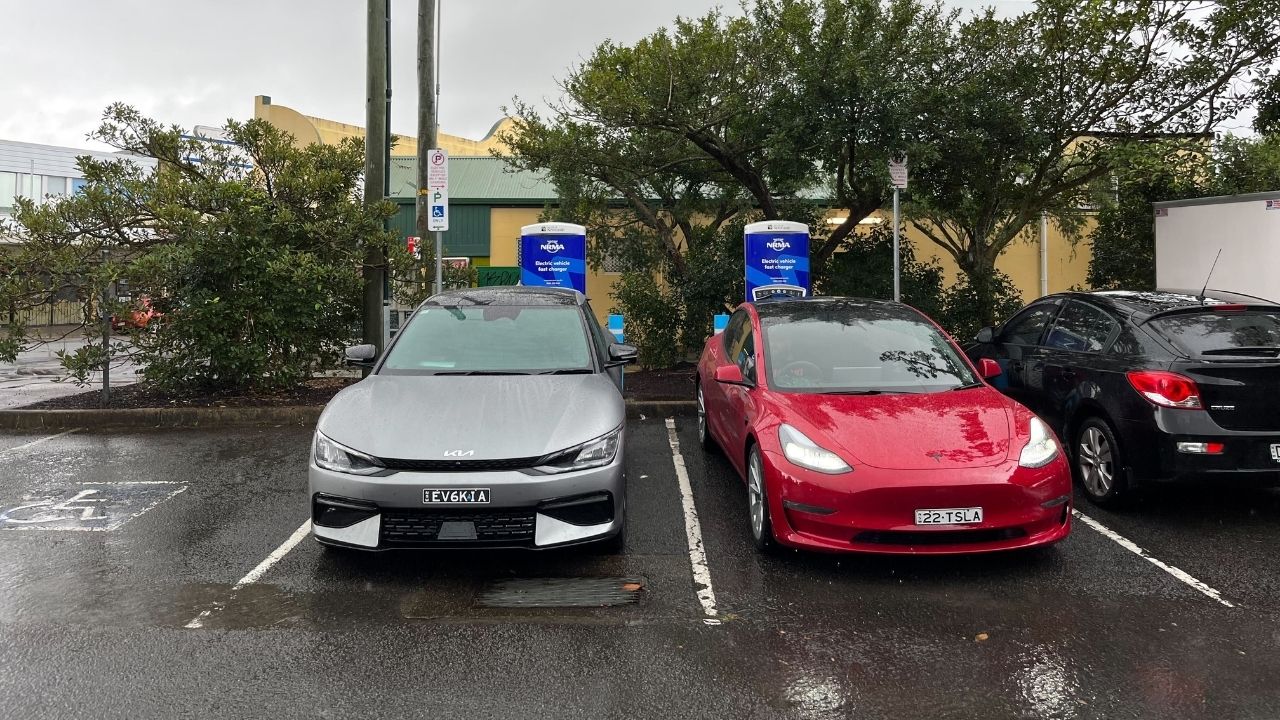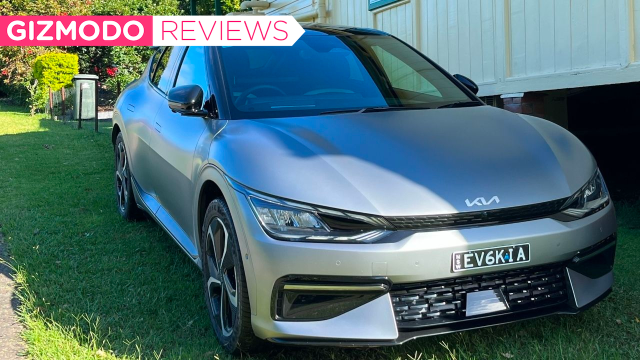The Kia EV6 is an electric SUV, ranging from $67,990 all the way up to $82,990. It’s a very advanced car, packing some of the best technology Kia has ever brought to the road, however much of that technology is outmatched by EV-focused companies like Polestar and Tesla.
There’s no denying that the Kia EV6 is an attractive car, though it’s bested in terms of range, operating system and, in a lot of ways, price. It’s also an incredibly difficult car to purchase. I spent a week with the EV6 and built up some thoughts.
Sexy in an evil way
Let’s start with the obvious: the Kia EV6 is a beautiful car. Aesthetically, it looks like a player vehicle from Cyberpunk 2077, minus the lawlessness. More than once, people that I showed the car to said it looked quite evil. It takes similar queues to the Hyundai Ioniq 5, Hyundai’s answer to the EV6, although it goes in a different direction (both cars are aimed at the Model Y).
It’s a very deliberate design that leans in on Kia’s typical car aesthetic and the more futuristic glam that supports many electric vehicles. Deliberate strong curves instead of bulbous, rounded areas.
Internally, the GT-Line models keep the aesthetic strong. The driver’s seat and passenger seat make you feel like you’re an extra in a sci-fi movie, with blue lights trimming the doors and the dash. Moreover, the infotainment system is oriented toward the driver, giving them a good view of what’s on screen. It also wraps around the dash, ending above the centre console.
It’s in the backseat that I think the aesthetic is, unfortunately, let down. While the front seats look strong and modern, the backseat looks a bit cheap in comparison. Compared to the backseats of the Tesla Model 3 and the Polestar 2, which are admittedly more neutral, I think it doesn’t hold up when compared to the rest of the car.
Regardless of style, comfort is strong in the Kia EV6. The seats are nice and soft to sink into and visibility through the windshield is large (though there is some annoying glare to be had from the sun on the middle armrest). The driver’s seat can be adjusted in any direction and even retracts back and forward when you start the car (as in, when you turn the car off, the seat goes back to give you more comfort stepping out and in).
An ‘Electric crossover SUV’
This is what Kia bills the EV6 as on its website – not a small SUV, but a crossover one.
In my mind, if you’re going to bill your car as an SUV of any type, you need a spacious boot. The boot in the EV6 is not generously spacious, despite being able to store 490 litres (for comparison, the Tesla Model 3 can store 425 litres and is much deeper). It pulls off quite an illusion making you think it’s super spacious, with protruding sides above the back wheels that make the car look quite wide.
The boot is also not all that deep, but it’s accessible with a door that hinges right out of the way.
To move the backseats down for more boot room, you need to pull a lever on the corresponding side of the boot: this means you need to be quite flexible to pull the seats down from inside the car, or you need to lean in and do it from the back. An annoying gripe to have, especially when carmakers have solved this problem for decades now by simply having the release mechanism for the backseats on the seats themselves.
Despite this, I think it’s nicely sized as a small SUV, and is pretty comparable to the Polestar 2 or the Model 3 in terms of space.

Driving in style
The driving feel of the Kia EV6 is terrific: it handles brilliantly, its road awareness programming is phenomenal and the car projects a sophisticated hologram in front of the driver, displaying useful stats.
A hologram? Yup, the future is now. When the car is on, it projects a hologram onto the screen showing you essential information: your current speed, what speed you should be doing in this area, if cruise control and pilot assistance is on, and even your next turn via the inbuilt GPS.
This feature was really well made and it almost felt like a videogame. Coming up on my next turn, the car would form arrows on the hologram indicating where I should turn next. There was the odd road where this didn’t work well, but overall it was really impressive.
Like in the Polestar 2, the inbuilt driving assistance system (kind of like an autopilot that helps you steer, if it sees white lines on both sides of the road) was very impressive, terrific for highway driving. I’d say this car wants to drive itself, but I would never let it (because this isn’t legal just yet).
The model I reviewed also features a 3D camera, which gave me vision around the car, making tight turns and parking super easy. It’s not available on the cheapest model and is one of the features reserved for the GT-Line models (as is the hologram).
I was also pretty impressed with the “i-Pedal mode”, which lets you drive with only the accelerator (the car controls its own braking). This was a neat feature to use around Sydney, however, I would never trust it completely, with my left foot at the ready. Additionally, I was a big fan of being able to adjust the regenerative braking intensity through pedals on the back of the steering wheel.
Moreover, in testing, I managed to get the car to go from 0 to 100 in 5.18 seconds (near the 0 to 100 in 5.2 seconds advertised speed). That is insanely fast, supported by this car’s selective AWD and RWD drive type on the fly (in the GT model). Each model sports a 77.4 kwh battery.
Here are the specs that each model offers:
Air (RWD)
- $67,990
- 19-inch alloy wheels
- Dual curved display
- V2L interior
- AEB with Junction Turning
- Blind-spot detection and rear cross-traffic alerts
- Lane keep assist and lane following assistance
- Centre side airbag
- Multi collision braking
GT-Line (RWD)
- $74,990
- 20-inch alloy wheels
- GT-Line body kit
- Premium relaxation front seats
- Active sound design
- Augmented reality heads up display (hologram)
- 14 speaker Meridian sound system
- Heated and ventilated front seats
- V2L exterior and interior
- Blind-spot view monitor
- 3D surround-view camera
- Remote parking assistance
GT-Line (AWD)
- $82,990
- 20-inch alloy wheels
- GT-Line body kit
- Wide sunroof
- Premium relaxation front seats
- Active sound design
- Augmented reality heads up display (hologram)
- 14 speaker Meridian sound system
- Heated and ventilated front seats
- V2L exterior and interior
- Blindspot view monitor
- 3D surround-view camera
- Remote parking assistance

Addicted to Android
Perhaps the Polestar 2 spoiled me, but I was unsatisfied with the integrated operating system of the Kia EV6. Though it’s capable and comes with (wired) Android Auto and Apple Carplay support, the inbuilt operating system got on my nerves more than once.
The GPS system, which is what you’d spend most of your time using through the centre console (because what other infotainment feature would you devote so much time to) isn’t terrific. It’s cumbersome with unnecessary screens and won’t generate results you type in unless they’re perfectly typed. In contrast to Google Maps, AKA the integrated Android map service for Android Automotive operating systems, it’s a pretty poor experience.
Moreover, it feels dated. The user experience of the GPS app is generally not very good, with it lagging and bemoaning any finger dragging across the map. To my surprise as well, there were occasions where I’d type an address and it’d calculate directions… For a previously typed address. “Just use Android!” I cry.
Adding to this, every integrated app in the infotainment system is cumbersome and difficult to use. This includes the radio and the media playback system.
Although one could argue that you’d get used to it, that’s not good enough for me: it looks bad to begin with and lacks the simplicity and straightforward “You’ve got a problem? Here’s a solution!” approach of integrated Android Automotive experiences. Though it leans in on Kia’s aesthetic, I suspect we’ll see a shift away from these proprietary infotainment systems in the future, given the simplicity of Android Automotive OS (not to be confused with Android Auto, which leans into Android phone integration. Android Automotive is a full operating system).

Range and price
For the price, the Kia EV6 is quite standard in terms of range, probably slightly below average. The cheapest EV6 model, the Air ($67,990), features a maximum WLTP (Worldwide Harmonised Light Vehicle Test Procedure) range of 528 kilometres, whereas the GT-Line RWD model ($74,990) features a range of 504 kilometres.
The GT-Line AWD ($82,990), which I reviewed, featured a range of 484 kilometres. Depending on if you had the aircon on and what intensity it was set to, along with what drive type you had on (“eco” mode for the most efficiency) the remaining kilometres calculation is adjusted.
I don’t think I could have achieved 484 kilometres in this car under pretty standard conditions (sunny weather on eco mode with aircon on at the lowest setting). At 98 per cent in fair conditions, the car projected a range of 384 kilometres with aircon set to low and in eco mode. Worth noting, too, I was definitely feeling more range anxious than in the Polestar 2 (which had a WLTP range of 540 kilometres in the model I reviewed).

Regardless, I don’t think the battery is a reason not to buy this car. 400 kilometres is a perfectly fine range for a city-tripping electric vehicle at the moment, and in fairness, it’s not the selling point of this vehicle (the selling point is the luxury aspect).
Over my week of use, I clocked around 1,000 kilometres of travel. Stopping at fast chargers along the way five hours north of Sydney (one 50 kwh charger and one 350 kwh charger) I didn’t encounter any problems with recharging the EV6 (aside from an out of order station at the Wallsend NRMA charger).
Should I buy the Kia EV6?
To be honest, it’s quite a difficult sell. Though the Kia EV6 starts at $67,990, its closest popular rival is the Tesla Model 3 Standard Range Plus, which currently retails for $63,900 in Australia. $5,000 is a lot of money to save when shopping for a car, but overall, when you know that you can get a really nice user experience at a similar price (such as with the Polestar 2, which retails for $59,900) I’m not sure the glamour of the Kia EV6 holds up.
Perhaps this is the best way to break it down: I think it’s a comfortable, attractive car with a pretty standard range and an operating system that, while isn’t perfect, is useable. It feels more luxurious than a standard glitz-free Model 3, but you pay $5,000 for that.
I’m not sure if the Kia EV6 GT-Line AWD is worth the price it’s asking for ($82,990), but the cheaper GT-Line RWD model ($74,990) seems like a sensible compromise if you want extra features. If you’re a rev-head, you might like the power the EV6 GT-Line AWD is packing, but I think there’s value in considering your alternatives. Going upmarket to the BMW iX1, for example, and I think the EV6 might be worth considering.
You can buy the Kia EV6 from Kia, but just be aware that availability isn’t terrific. Across all of 2022, only 500 cars have been allocated for Australian dealerships. Other electric vehicles are also undergoing similar supply shortages, however.
Want more Aussie car news? Here’s every EV we’ve reviewed in the last two years, all the EVs we can expect down under soon, and our guide to finding EV chargers across the country. Check out our dedicated Cars tab for more.
